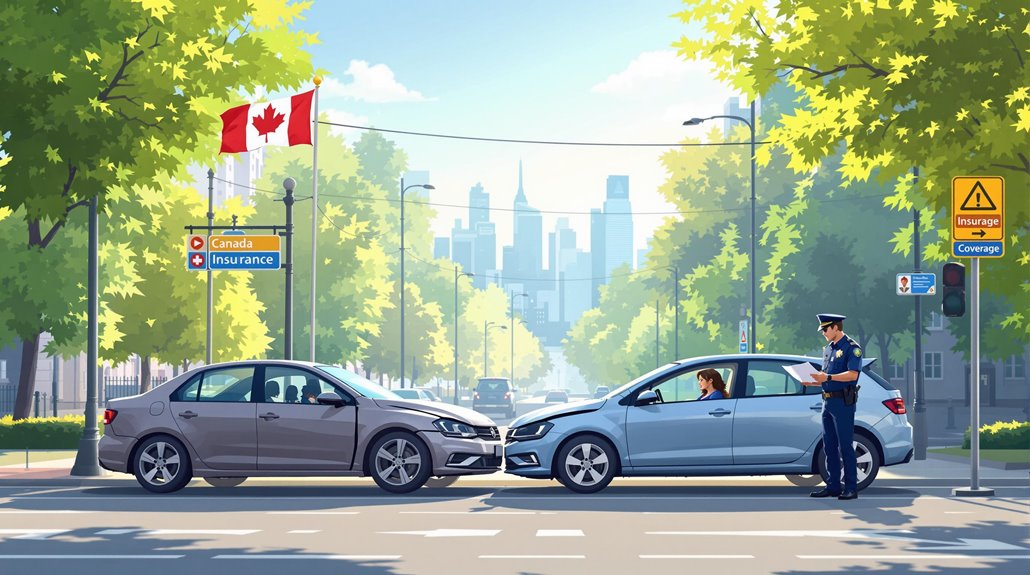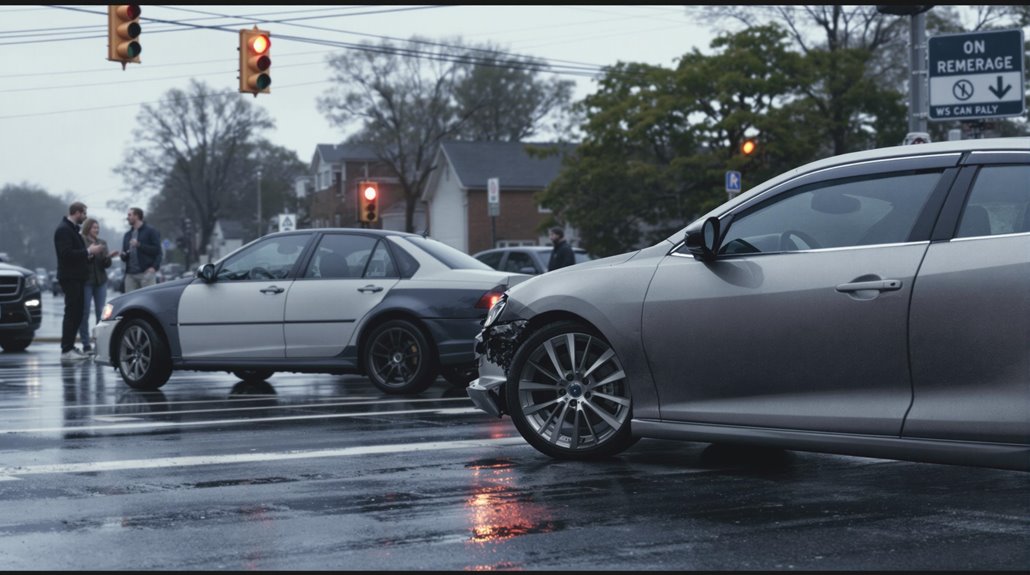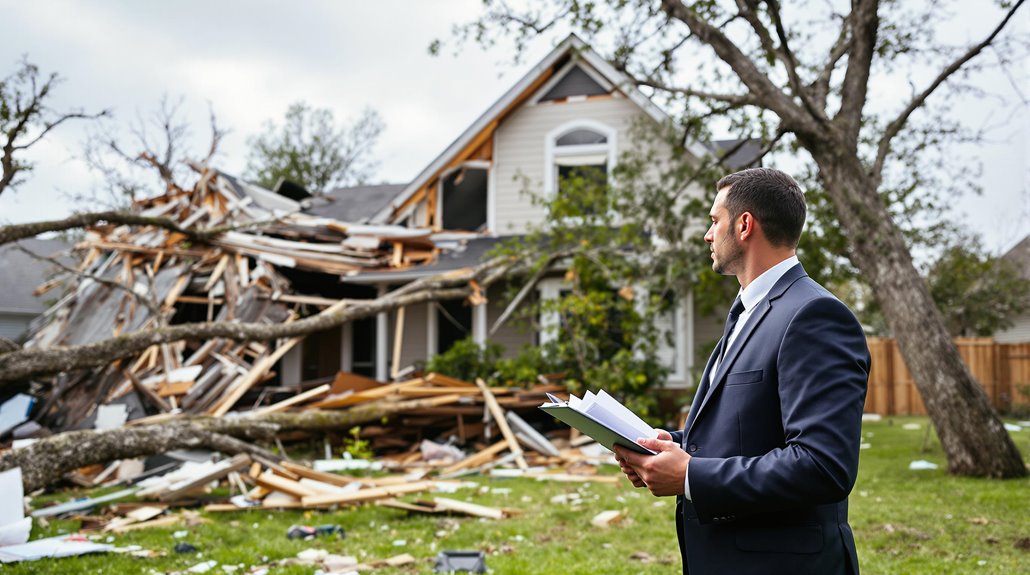Direct Compensation Property Damage (DCPD) is a distinct type of car insurance coverage for no-fault collisions. Available in provinces such as Ontario, Quebec, and Alberta, DCPD allows policyholders to deal directly with their own insurance company for claims related to vehicle damage and contents. This coverage is typically included with third-party liability insurance and provides a streamlined claims process without reliance on the at-fault party's insurance. Exploring the specifics of DCPD can provide further insight into its benefits and application.
Key Takeaways
- Direct Compensation Property Damage (DCPD) is a type of car insurance coverage for no-fault collisions in certain provinces.
- DCPD allows policyholders to deal directly with their own insurance company, simplifying the claims process.
- It covers damage to vehicles and contents, rental replacement, and transportation costs when another party is at fault.
- DCPD guarantees a streamlined claims process without reliance on the at-fault party's insurance, reducing stress and hassle.
- It is a standard inclusion with third-party liability insurance in provinces such as Ontario, Quebec, and Alberta.
Key Definitions and Overview of DCPD
Direct Compensation Property Damage (DCPD) is a distinct type of car insurance coverage that plays an essential role in facilitating claims resolution in no-fault collisions involving third parties.
As a standard inclusion in policies with third-party liability insurance, DCPD is available in several provinces, including Ontario, Quebec, Alberta, New Brunswick, Newfoundland and Labrador, Nova Scotia, and Prince Edward Island.
This insurance coverage simplifies the claims process by allowing policyholders to deal directly with their own insurer, rather than the at-fault party's insurance company.
A DCPD overview reveals that it covers damage to the vehicle and its contents, along with rental replacement and transportation costs during repair.
As a mandatory component of insurance policies in specified provinces, DCPD provides financial protection for vehicle and contents damage, reducing the financial burden on the insured.
This essential insurance coverage guarantees a streamlined claims process, providing immediate compensation without relying on the other party's insurance.
How Direct Compensation Property Damage Works

Direct Compensation Property Damage operates by streamlining the claims process, allowing individuals to deal directly with their own insurance company rather than the at-fault driver's insurer.
This approach facilitates quicker fault determination and claims resolution, as the involvement of multiple insurance companies is eliminated.
Claims Process Simplified
While traversing the complexities of a no-fault collision with a third party can be a challenging experience for drivers, the introduction of Direct Compensation Property Damage (DCPD) significantly simplifies the claims process. DCPD streamlines claims by allowing drivers to deal directly with their own insurance company, eliminating the need to pursue third-party decisions or deal with the at-fault driver's insurance company.
| Claims Process Steps | Key Benefits | Policy Inclusions |
|---|---|---|
| Gather information, document the scene, notify insurer | Covers vehicle and contents, rental replacement, no legal action | Standard inclusion with third-party liability insurance |
| Track claim and provide additional information | Streamlined process, financial protection | Mandatory in provinces such as Ontario, Quebec, and Alberta |
| Collect compensation directly from insurance company | Reduces stress and guarantees quick vehicle repair | Optional deductibles and specific coverage for property damage |
Determining Fault Quickly
The streamlined claims process facilitated by Direct Compensation Property Damage relies heavily on the efficient and accurate determination of fault. To quickly determine fault, insurers use established fault determination rules, such as the Fault Determination Guidelines, which assess responsibility for the accident considering factors such as driver actions and traffic laws.
Key factors like breach of duty and causation are vital in determining fault. Technology and data are also employed to guarantee accurate fault assessment. Insurers review various sources of information, including statements, medical records, and video footage, to make an objective evaluation.
Effective negotiation strategies can facilitate a fair resolution of claims. By accurately determining fault, insurers can efficiently settle claims, reducing the complexity and duration of the claims process.
Benefits of Direct Compensation Property Damage

Direct Compensation Property Damage (DCPD) provides several benefits, including a reduction in stress and hassle associated with the claims process.
By allowing policyholders to receive immediate compensation from their own insurance company, DCPD eliminates the need to wait for a third-party decision, thereby speeding up the claim process.
This streamlined approach enables policyholders to focus on repairing or replacing their vehicle, rather than traversing a complex and time-consuming claims process.
Reduces Stress and Hassle
Uncertainty and frustration often accompany the aftermath of a vehicle accident, particularly when steering the complex process of seeking compensation for property damage. Direct Compensation Property Damage reduces stress and hassle by allowing drivers to deal directly with their own insurer, eliminating the need to pursue the at-fault driver's insurance company for compensation. This simplifies the claims process, guaranteeing quicker resolutions and less hassle for drivers after an accident.
| Benefit | Description |
|---|---|
| Simplified Claims Process | Allows dealing directly with own insurer |
| Reduced Stress | Eliminates need to pursue at-fault driver's insurance company |
| Quicker Resolutions | Guarantees quicker resolutions and less hassle for drivers after an accident |
This approach provides stress relief and claims simplicity, enabling drivers to focus on recovering from the accident rather than steering a complicated claims process.
Speeds Up Claim Process
Filing a claim after a vehicle accident can be a time-consuming and arduous process, often exacerbating the stress and hassle that accompany such events.
Direct Compensation Property Damage simplifies claim processing by allowing policyholders to file claims directly with their own insurance company. This eliminates the need to deal with third-party insurers, reducing complexity and enabling faster communication and processing. Additionally, this method empowers policyholders to have more control over their claims, as they can directly engage with their insurer and receive timely updates on the status of their case. By streamlining the process, policyholders can more easily manage the financial implications of an incident, ensuring they receive appropriate compensation for property damage without the added stress of negotiating with multiple parties. Ultimately, this approach fosters a smoother experience for those affected by property damage, enhancing customer satisfaction and trust in their insurance provider.
As a result, claims are resolved more quickly, with 90% settled without legal action. Insurance communication is also streamlined, facilitating quicker access to necessary repairs and replacements.
Provinces Where DCPD Is Mandatory

Across Canada, the implementation of Direct Compensation Property Damage (DCPD) varies by province, with some jurisdictions mandating its inclusion in auto insurance policies. Provinces such as Alberta, Quebec, New Brunswick, Nova Scotia, Newfoundland and Labrador, and Prince Edward Island require DCPD coverage as part of their auto insurance policies.
However, there are DCPD exceptions, such as in Alberta, where policyholders can opt out with a "DCPD deletion endorsement" in certain cases. Additionally, Ontario, which previously mandated DCPD, has made it optional as of January 1, 2024.
These provincial differences highlight the varying approaches to implementing DCPD. In provinces where DCPD is mandatory, it is typically part of the no-fault insurance system, aimed at streamlining claims and providing direct compensation for vehicle repairs. The mandatory inclusion of DCPD in these provinces simplifies the claims process for policyholders.
Provincial regulations dictate the specifics of DCPD implementation.
Conditions for Direct Compensation Property Damage Application

Provided that the necessary requirements are met, Direct Compensation Property Damage (DCPD) coverage can be applied in specific circumstances. The application requirements for DCPD involve several key factors, including location, vehicles, and parties involved, as well as specific accident conditions and insurance policy requirements.
Some notable conditions include:
- The accident must occur within a specified jurisdiction, including Ontario, Alberta, Québec, or Atlantic Canada, and the insurer must be licensed in that jurisdiction or have signed the undertaking.
- At least one vehicle must be involved in the accident, with a third party identified and insured vehicles protected by DCPD coverage.
- The accident must meet the fault determination rules under the Insurance Act, with DCPD providing direct compensation from the insured's own insurance company if the criteria are met.
Jurisdiction differences also play a role in the application of DCPD, with each jurisdiction having specific rules for determining fault in DCPD claims.
Understanding Fault Determination in DCPD Claims

When an accident occurs, determining fault is a critical step in the Direct Compensation Property Damage (DCPD) claims process. Insurers use standardized fault determination rules to assess accident responsibility, considering factors such as driver actions, traffic laws, weather, road conditions, and point of impact on the vehicle.
These rules, outlined in the Insurance Act, guarantee objective and consistent assessments. The insurer handles fault determination directly with their policyholder, eliminating the need for third-party negotiations.
The outcome of fault determination affects premium adjustments, but not the payout of the claim. If the policyholder is not at fault, they typically do not pay a deductible. In cases of partial fault, the policyholder may be required to pay a portion of the deductible under collision coverage.
The standardized guidelines and clear rules governing fault assessment in DCPD claims promote fair and consistent compensation, reducing disputes and complexities.
What DCPD Covers and What It Doesn't

The scope of Direct Compensation Property Damage (DCPD) coverage is an indispensable aspect of understanding this mandatory auto insurance component in certain provinces.
DCPD allows policyholders to deal directly with their insurance company for property damage claims, regardless of fault. This coverage provides several advantages, including expedited claims processing and compensation.
Key aspects of DCPD coverage include:
- Damage to vehicles and/or their contents when another person is fully or partly at fault for the accident
- Claims are processed directly by the policyholder's insurance company without waiting for a third-party decision
- DCPD is a standard inclusion in auto insurance policies when third-party liability insurance is purchased
However, DCPD limitations include non-coverage for damages if the policyholder is at fault for the accident, non-vehicle related damages, and third-party claims.
Understanding these DCPD advantages and limitations is significant for policyholders to navigate the insurance process effectively.
How DCPD Affects Your Auto Insurance Premiums

How substantially does Direct Compensation Property Damage (DCPD) impact auto insurance premiums? DCPD affects premiums in various ways, depending on factors such as vehicle year, make, model, and likelihood of collision.
| Change in Premium | Percentage of Drivers | Description |
|---|---|---|
| Reduction | 42% | Lower premiums due to DCPD implementation |
| No change | 15% | No impact on premiums |
| Increase (0-5%) | 34% | Higher premiums due to vehicle-specific factors |
| At-fault increase | N/A | Higher premiums for at-fault drivers |
| Not-at-fault | N/A | No impact on premiums for not-at-fault damage coverage |
DCPD provides premium insights by aligning insurance premiums with repair costs. Vehicle-specific factors influence premium adjustments, considering at-fault status for rating purposes. DCPD offers an efficient and customer-focused claims process, but at-fault drivers may face increased premium rates due to cost implications. Overall, DCPD has a significant impact on auto insurance premiums, reflecting individual circumstances and driving habits.
The Benefits Of Consulting A Public Adjuster

Consulting a public adjuster can provide significant benefits to individuals dealing with direct compensation property damage claims.
A public adjuster's expertise in insurance claims and objective damage assessment enables them to accurately evaluate property damage, identify all relevant losses, and prepare detailed reports necessary for successful claims.
Claims handled by public adjusters have shown 800% higher settlements compared to those without professional representation.
Expertise In Insurance Claims
In traversing complex insurance claims, policyholders often find significant benefits in seeking the guidance of a public adjuster. The claims expertise of a public adjuster offers several distinct advantages.
- A public adjuster possesses knowledge of insurance policies and procedures, including policy interpretation, which guarantees that all benefits are received.
- With policy expertise, they can navigate long, complicated policies and claim procedures, effectively work within the relevant legal frameworks, and provide thorough policy reviews to determine the best claims strategy.
- Their procedural knowledge enables them to handle complex claims processes, which minimizes delays and complications in resolving claims.
Public adjusters typically charge 5-20% contingency fee of the final settlement amount, making their services accessible without upfront costs.
Objective Damage Assessment
A thorough understanding of insurance policies and procedures is only the foundation of a successful claims process.
Objective damage assessment is a critical component, ensuring that the extent of damages is accurately determined. Consulting a public adjuster provides policyholders with an impartial and detailed evaluation of damages, preventing underestimation and identifying hidden damages that might be missed by insurance company adjusters.
Through professional inspection and damage verification, public adjusters gather extensive documentation, including photographs, videos, and written reports, to support claim valuation and negotiation.
This objective assessment facilitates a fair and accurate evaluation of damages, ultimately leading to a stronger claim and a more favorable settlement for the policyholder.
Licensed professionals must maintain complete independence from insurance companies while advocating for homeowners throughout the claims process.
Streamlined Claim Process
Efficiency is a hallmark of a well-managed insurance claims process. In the context of Direct Compensation Property Damage (DCPD), a streamlined claim process is essential for ensuring that policyholders receive timely and fair compensation for damages to their vehicle.
- DCPD simplifies the claims process by allowing drivers to claim damages directly from their own insurer, regardless of fault.
- Public adjusters contribute to claim efficiency by preparing detailed claims, working with the insurance company, and advocating on behalf of the policyholder.
- Both DCPD and public adjusters aim to reduce the complexity and time required for claim resolution, resulting in improved claims handling and enhanced overall experience for drivers.
This streamlined process underscores the benefits of consulting a public adjuster for efficient claim handling. Claims handled by public adjusters typically result in 574% higher settlements compared to those without professional representation.
Higher Claim Payouts & Settlements
How much of a difference can a public adjuster make in the outcome of an insurance claim? Industry statistics show that homeowners who hire public adjusters receive higher settlements, often three to five times higher than those without a public adjuster. A public adjuster's expertise in interpreting policy coverage and exclusions helps guarantee that nothing is overlooked, resulting in more accurate damage assessments and better repair estimates. Members of Public Claims Adjusters Network maintain strict professional standards including 24-hour communication response times and regular claim status updates every 10 days.
| Benefits of Public Adjusters | Impact on Insurance Claims |
|---|---|
| Higher settlements | Claims payouts are often 3-5 times higher |
| Expertise in policy coverage | Guarantees accurate damage assessments and better repair estimates |
| State-licensed professionals | Work exclusively for policyholders, preventing underpayment of damages |
| Negotiation tactics | Secure better settlements through effective claim strategy |
About The Public Claims Adjusters Network (PCAN)

With the complexities of insurance claims and property damage issues often overwhelming policyholders, the Public Claims Adjusters Network (PCAN) offers extensive solutions to help individuals maneuver through these challenges.
As a thorough claims management solution provider, PCAN provides expert analysis and interpretation of insurance policies, documentation and submission of claims, and negotiation with insurance carriers on behalf of policyholders.
Key benefits of utilizing PCAN's services include:
- Expert claims advocacy to maximize claim payouts and guarantee timely and fair settlements
- Specialized knowledge in managing complex insurance claims and policy negotiation
- Efficient handling of paperwork and communication with insurers to reduce the burden on policyholders
Unlike insurance company adjusters who protect insurer interests, PCAN's public adjusters work exclusively to represent policyholder interests throughout the claims process.
References
- https://www.johnson.ca/faq/auto-insurance/qid/direct-compensation-property
- https://begininsurance.ca/en/blog/what-is-direct-compensation-in-auto-insurance
- https://legacy.utcourts.gov/committees/muji/All_Minutes.pdf
- https://northerninsurancebrokers.ca/media-centre/what-is-direct-compensation/
- https://wp.stolaf.edu/cila/files/2020/09/Teaching-at-Its-Best.pdf
- https://www.onlia.ca/magazine/blogs/car-insurance-coverage-direct-compensation-property-damage
- https://www.mychoice.ca/blog/direct-compensation-property-damage-insurance-ontario/
- https://youset.ca/en/blog/is-direct-compensation-property-damage-mandatory/
- https://rates.ca/resources/demystifying-direct-compensation-property-damage-coverage
- https://www.thinkinsure.ca/insurance-help-centre/direct-compensation-property-damage.html








